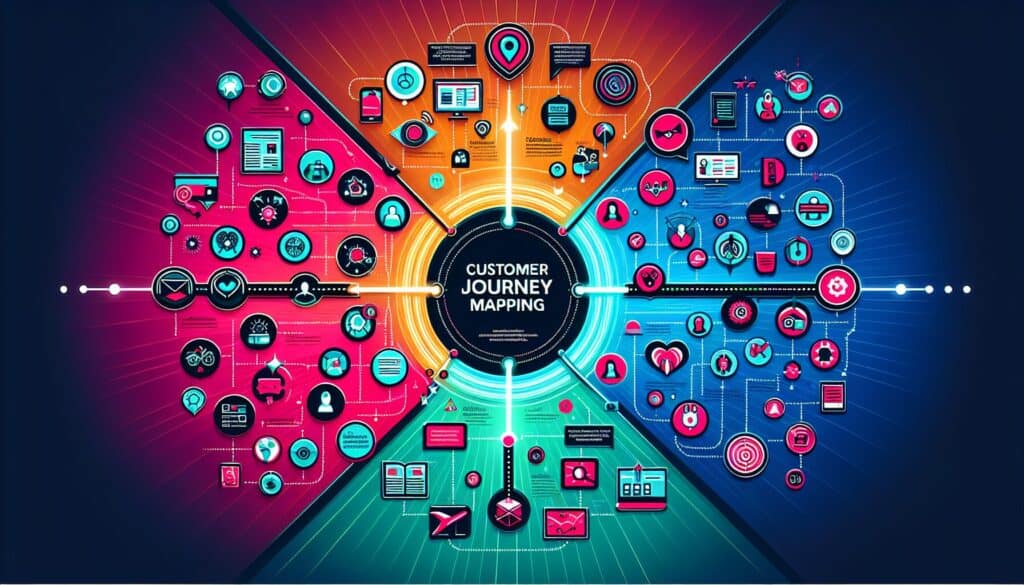Una visualizzazione dell'esperienza end-to-end di un cliente con un'organizzazione o un prodotto, attraverso tutti i punti di contatto e i canali, dal suo punto di vista.
- Metodologie: Ingegneria, Qualità
Mappatura del viaggio del cliente

Mappatura del viaggio del cliente
- Miglioramento continuo, Esperienza del cliente, Mappatura del viaggio del cliente, Assistenza clienti, CX, Pensiero progettuale, Mappatura dei processi, Esperienza utente (UX), Progettazione incentrata sull'utente
Obiettivo:
Come si usa:
- Si tratta di ricercare e delineare le varie fasi che un cliente attraversa (ad esempio, consapevolezza, considerazione, acquisto, post-acquisto), le sue azioni, i suoi pensieri, le sue emozioni, i suoi punti dolenti e le opportunità di miglioramento in ciascuna fase. Spesso viene presentata come una mappa visiva.
Professionisti
- Fornisce una comprensione olistica dell'esperienza del cliente; aiuta a identificare i punti dolenti e i momenti di verità; favorisce l'empatia per i clienti in tutta l'organizzazione; evidenzia le opportunità per migliorare la soddisfazione e la fedeltà dei clienti.
Contro
- Può richiedere molto tempo per la ricerca e la creazione; se non è fatto bene, può semplificare eccessivamente percorsi complessi o segmenti di clienti diversi; richiede una collaborazione interfunzionale per l'accuratezza e il coinvolgimento; deve essere aggiornato in base all'evoluzione dei comportamenti e dei punti di contatto dei clienti.
Categorie:
- Clienti e marketing, Ideazione, Progettazione del prodotto
Ideale per:
- Comprendere e migliorare l'esperienza complessiva del cliente visualizzando e analizzando tutte le interazioni che un cliente ha con un'azienda o un prodotto.
Customer Journey Mapping serves a variety of applications across numerous sectors, including e-commerce, healthcare, and technology, playing a significant role in both product development and service design phases. Typically initiated by product managers or user experience designers, this methodology involves collaboration with cross-functional teams, including marketing, customer service, and R&D, to gather comprehensive data on customer interactions. In an e-commerce context, for instance, mapping can reveal obstacles customers encounter during the checkout process, leading to the design of more efficient payment options or clearer communication regarding shipping – both of which can enhance the purchasing experience. In healthcare, understanding the emotional and psychological states of patients can drive improvements in service delivery and communication strategies. Executed effectively, this mapping process not only visualizes customer touchpoints but also serves as a framework for iterative design sessions, allowing teams to prioritize enhancements based on identified pain points. Companies can leverage insights from this analysis to refine their value propositions, foster customer loyalty through improved satisfaction, and ultimately drive business growth through deeper engagements with their clientele. This methodology also reinforces an empathetic corporate culture, as stakeholders across the organization become more attuned to customer needs and behaviors, leading to a more cohesive strategy that aligns all departments toward enriching user experiences.
Fasi chiave di questa metodologia
- Define specific customer personas.
- Identify and outline distinct stages of the customer experience.
- Map out customer actions within each stage.
- Document customer thoughts and feelings at each stage.
- Identify customer pain points and areas of friction.
- Highlight key interactions and moments of truth.
- Spot opportunities for enhancement in the customer lifecycle.
- Visualize the data in a coherent format for analysis.
- Gather feedback on the map from stakeholders.
- Iterate on the map based on feedback and new insights.
Suggerimenti per i professionisti
- Utilize data analytics and customer feedback to identify trends and correlations across different touchpoints, ensuring that the map reflects behaviors grounded in actual usage patterns.
- Involve cross-functional teams throughout the mapping process to gather diverse perspectives, promoting a unified understanding of customer experiences and pain points.
- Regularly revisit and update the map based on new data and evolving customer needs, ensuring relevance and maintaining alignment with organizational objectives.
Leggere e confrontare diverse metodologie, raccomandiamo il
> Ampio archivio di metodologie <
insieme ad altre 400 metodologie.
I vostri commenti su questa metodologia o ulteriori informazioni sono benvenuti su sezione commenti qui sotto ↓ , così come tutte le idee o i link relativi all'ingegneria.
Contesto storico
1960
1980
1983
1990
1995
2000
2010
1950
1980
1980
1986
1994
1995
2000
(se la data non è nota o non è rilevante, ad esempio "meccanica dei fluidi", viene fornita una stima approssimativa della sua notevole comparsa)














Post correlati
Questionari sul disagio muscoloscheletrico
Test multivariati (MVT)
Analisi di regressione multipla
Sistemi di cattura del movimento
Metodo MoSCoW
Test mediano dell'umore